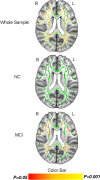Increased Left Ventricular Mass Index Is Associated With Compromised White Matter Microstructure Among Older Adults
- PMID: 29945917
- PMCID: PMC6064880
- DOI: 10.1161/JAHA.118.009041
Increased Left Ventricular Mass Index Is Associated With Compromised White Matter Microstructure Among Older Adults
Abstract
Background: Left ventricular (LV) hypertrophy is associated with cerebrovascular disease and cognitive decline. Increased LV mass index is a subclinical imaging marker that precedes overt LV hypertrophy. This study relates LV mass index to white matter microstructure and cognition among older adults with normal cognition and mild cognitive impairment.
Methods and results: Vanderbilt Memory & Aging Project participants free of clinical stroke, dementia, and heart failure (n=318, 73±7 years, 58% male, 39% mild cognitive impairment) underwent brain magnetic resonance imaging, cardiac magnetic resonance, and neuropsychological assessment. Voxelwise analyses related LV mass index (g/m2) to diffusion tensor imaging metrics. Models adjusted for age, sex, education, race/ethnicity, Framingham Stroke Risk Profile, cognitive diagnosis, and apolipoprotein E-ε4 status. Secondary analyses included a LV mass index×diagnosis interaction term with follow-up models stratified by diagnosis. With identical covariates, linear regression models related LV mass index to neuropsychological performances. Increased LV mass index related to altered white matter microstructure (P<0.05). In models stratified by diagnosis, associations between LV mass index and diffusion tensor imaging were present among mild cognitive impairment participants only (P<0.05). LV mass index was related only to worse visuospatial memory performance (β=-0.003, P=0.036), an observation that would not withstand correction for multiple testing.
Conclusions: In the absence of prevalent heart failure and clinical stroke, increased LV mass index corresponds to altered white matter microstructure, particularly among older adults with clinical symptoms of prodromal dementia. Findings highlight the potential link between subclinical LV remodeling and cerebral white matter microstructure vulnerability.
Keywords: cognitive impairment; diffusion‐weighted imaging; left ventricular mass; white matter disease.
© 2018 The Authors. Published on behalf of the American Heart Association, Inc., by Wiley.
Figures


Similar articles
-
Left Ventricular Mass Index Is Associated With Cognitive Function in Middle-Age: Bogalusa Heart Study.Circ Cardiovasc Imaging. 2020 Aug;13(8):e010335. doi: 10.1161/CIRCIMAGING.119.010335. Epub 2020 Aug 10. Circ Cardiovasc Imaging. 2020. PMID: 32772573 Free PMC article.
-
Axonal Injury Partially Mediates Associations Between Increased Left Ventricular Mass Index and White Matter Damage.Stroke. 2022 Mar;53(3):808-816. doi: 10.1161/STROKEAHA.121.034349. Epub 2021 Oct 27. Stroke. 2022. PMID: 34702069 Free PMC article. Clinical Trial.
-
Associations of Echocardiography Markers and Vascular Brain Lesions: The ARIC Study.J Am Heart Assoc. 2018 Dec 18;7(24):e008992. doi: 10.1161/JAHA.118.008992. J Am Heart Assoc. 2018. PMID: 30526268 Free PMC article.
-
[Evaluation of the results of magnetic resonance imaging of the brain for cognitive impairment in patients with heart failure: A review].Ter Arkh. 2024 Oct 10;96(9):909-913. doi: 10.26442/00403660.2024.09.202853. Ter Arkh. 2024. PMID: 39467246 Review. Russian.
-
Predictors and assessment of cognitive dysfunction resulting from ischaemic stroke.Lancet Neurol. 2010 Sep;9(9):895-905. doi: 10.1016/S1474-4422(10)70164-2. Lancet Neurol. 2010. PMID: 20723846 Free PMC article. Review.
Cited by
-
Left Ventricular Hypertrophy and Cerebral Small Vessel Disease: A Systematic Review and Meta-Analysis.J Stroke. 2020 May;22(2):206-224. doi: 10.5853/jos.2019.03335. Epub 2020 May 31. J Stroke. 2020. PMID: 32635685 Free PMC article.
-
High-Sensitivity Troponin T, NT-proBNP, and Cognitive Outcomes in SPRINT.Hypertension. 2024 Sep;81(9):1956-1965. doi: 10.1161/HYPERTENSIONAHA.124.22876. Epub 2024 Jul 3. Hypertension. 2024. PMID: 38957975 Clinical Trial.
-
Volumetric brain MRI signatures of heart failure with preserved ejection fraction in the setting of dementia.Magn Reson Imaging. 2024 Jun;109:49-55. doi: 10.1016/j.mri.2024.02.016. Epub 2024 Feb 29. Magn Reson Imaging. 2024. PMID: 38430976 Free PMC article.
-
The effect of Alzheimer's disease genetic factors on limbic white matter microstructure.Alzheimers Dement. 2025 Apr;21(4):e70130. doi: 10.1002/alz.70130. Alzheimers Dement. 2025. PMID: 40219815 Free PMC article.
-
Impaired Frontal Brain Activity in Patients With Heart Failure Assessed by Near-Infrared Spectroscopy.J Am Heart Assoc. 2020 Feb 4;9(3):e014564. doi: 10.1161/JAHA.119.014564. Epub 2020 Jan 24. J Am Heart Assoc. 2020. PMID: 31973606 Free PMC article.
References
-
- Bikkina M, Levy D, Evans JC, Larson MG, Benjamin EJ, Wolf PA, Castelli WP. Left ventricular mass and risk of stroke in an elderly cohort. The Framingham Heart Study. J Am Med Assoc. 1994;272:33–36. - PubMed
-
- Kahonen‐Vare M, Brunni‐Hakala S, Lindroos M, Pitkala K, Strandberg T, Tilvis R. Left ventricular hypertrophy and blood pressure as predictors of cognitive decline in old age. Aging Clin Exp Res. 2004;16:147–152. - PubMed
-
- Lee S, Park J, Kwon S, Kim Y, Roh J, Yoon B. Left ventricular hypertrophy is associated with cerebral microbleeds in hypertension patients. Neurology. 2004;63:16–21. - PubMed
-
- Kohara K, Zhao B, Jiang Y, Takata Y, Fukuoka T, Igase M, Miki T, Hiwada K. Relation of left ventricular hypertrophy and geometry to asymptomatic cerebrovascular damage in essential hypertension. Am J Cardiol. 1999;83:367–370. - PubMed
Publication types
MeSH terms
Grants and funding
- T32 MH064913/MH/NIMH NIH HHS/United States
- UL1 TR000445/TR/NCATS NIH HHS/United States
- K23 AG048347/AG/NIA NIH HHS/United States
- U54 HD083211/HD/NICHD NIH HHS/United States
- R25 GM062459/GM/NIGMS NIH HHS/United States
- R24 HL085343/HL/NHLBI NIH HHS/United States
- K12 HD043483/HD/NICHD NIH HHS/United States
- K01 AG049164/AG/NIA NIH HHS/United States
- K24 AG046373/AG/NIA NIH HHS/United States
- R01 AG034962/AG/NIA NIH HHS/United States
- T32 GM007347/GM/NIGMS NIH HHS/United States
- K23 AG030962/AG/NIA NIH HHS/United States
- K23 AG045966/AG/NIA NIH HHS/United States
- S10 OD023680/OD/NIH HHS/United States
LinkOut - more resources
Full Text Sources
Other Literature Sources
Medical
Molecular Biology Databases

